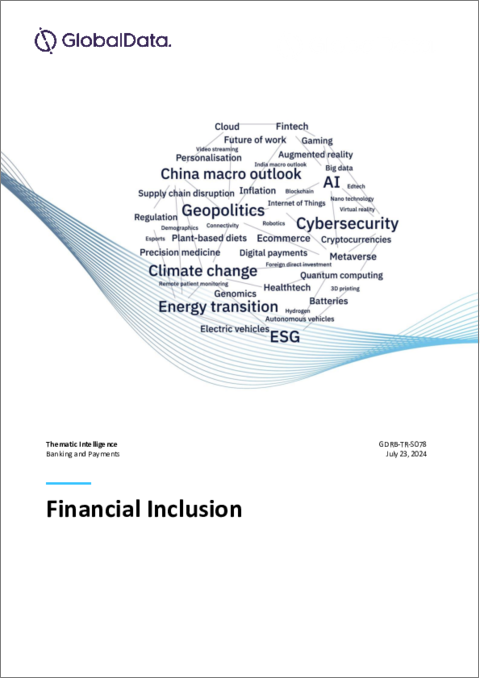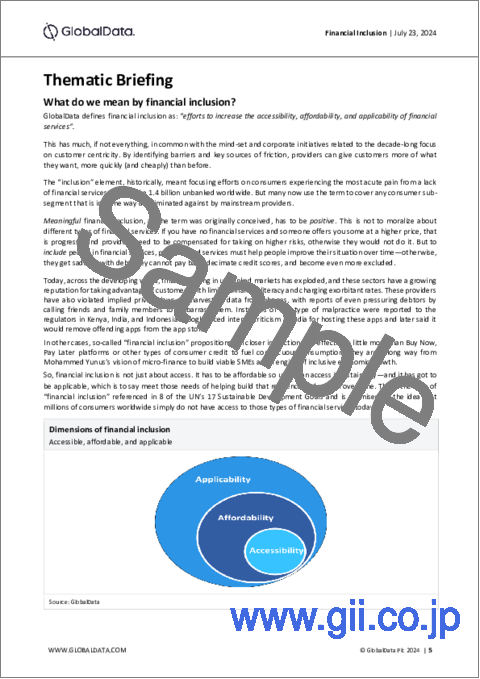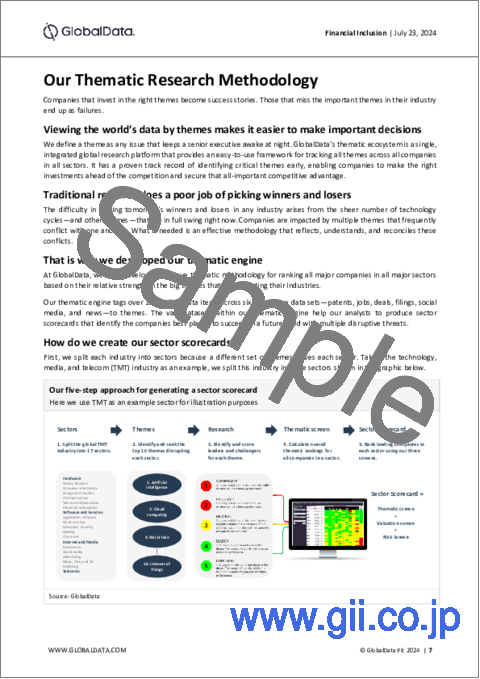|
|
市場調査レポート
商品コード
1535019
金融包摂:テーマ別インテリジェンスThematic Intelligence: Financial Inclusion |
||||||
カスタマイズ可能
適宜更新あり
|
|||||||
| 金融包摂:テーマ別インテリジェンス |
|
出版日: 2024年07月17日
発行: GlobalData
ページ情報: 英文 54 Pages
納期: 即納可能
|
- 全表示
- 概要
- 目次
2024年、金融包摂の取り組みは、4つの大きなカテゴリに分類される傾向にあります。発展途上国では、主流金融サービスから完全に排除されるわけではないにせよ、実質的な摩擦に直面している数百万人の銀行口座を持たない消費者や銀行口座を持たない消費者に焦点を当てた取り組みが行われています。先進国では主に、クレジットスコアや社会経済的地位のために銀行口座を持たない消費者や、国籍、民族性、ジェンダー、セクシュアリティのために主流プロバイダーから疎外されている消費者、金融サービスを利用することはできるが、強く抱いている政治的・宗教的信条を助長および支持するような方法では利用できない消費者に焦点を当てています。差異をより意識する政治情勢、セグメンテーションをより経済的に実行可能なものにするデジタル技術、より厳しいマクロ経済情勢の中で収益成長を促進するために新たな市場セグメントを発掘する必要性など、複数の要因が一致して、これらのタイプはそれぞれ優先事項となっています。
GlobalDataは金融包摂を「金融サービスのアクセスのしやすさ、入手のしやすさ、利用のしやすさを向上させる取り組み」と定義しています。これは、すべてではないにせよ、10年来重視されてきた顧客中心主義に関する考え方や企業の取り組みと共通する部分が多いです。障壁や摩擦の主因を特定することで、プロバイダーは顧客が望むものを以前よりも迅速に(そして安価に)提供することができます。歴史的に、「包摂」の要素は、世界で14億人の銀行口座を持たない消費者のように、金融サービスの欠如からもっとも深刻な悩みを経験している消費者に活動を集中することを意味していました。しかし、現在では、主流プロバイダーから何らかの差別を受けているあらゆる消費者サブセグメントをカバーするために、多くの人々がこの用語を使用しています。
当レポートでは、金融包摂市場について調査分析し、金融包摂の中核となる要素、技術動向、最新の規制動向、もっとも新規参入に適した時期にある市場などの情報を提供しています。
スコープ
- ブラジルのNubank、中国のWeBankやMYbank、インドのDigibank、アルゼンチンのUala、南アフリカのTymeBankなど、世界でもっとも成功している新しいデジタルバンクの多くは主に、金融包摂の経済性をテーマにしています。
- 資金調達環境が大幅に厳しくなっているにもかかわらず、モバイルの普及率が高くても銀行口座のある人口が少ない市場には多額の投資資金が流入し続けています。
- 金融包摂を目指すスタートアップの多くは、ターゲットとする層の主な送金通路をターゲットとし、その後追加的な金融サービスに進出しています。GlobalDataの2023 Financial Services Consumer Surveyによると、家族や友人に国外送金をする人は、送金をしない人に比べて金融詐欺に遭ったことがある可能性が約4倍高いことが明らかになっています。
- アルコール消費は、消費者がより健康的なライフスタイルを追求する際に、行動を変える最初の焦点の1つです。
- 世界の飲酒者の半数は、アルコール飲料が自分の心身の健康にどのような影響を与えるかによって製品の選択に影響を受けることが多い、または常に影響を受けると回答しています。
- アルコール消費者の3分の2超が、栄養の強化された製品に多少なりとも魅力を感じています。
目次
- エグゼクティブサマリー
- 企業
- テーマのブリーフィング
- 動向
- 技術動向
- マクロ経済と社会の動向
- 規制動向
- 産業の分析
- タイムライン
- バリューチェーン
- 企業
- 発展途上国における銀行口座を持たないフィンテック
- 先進国における銀行口座を持たないフィンテック
- 疎外されたセグメンテーションされたフィンテック
- 意識の高いコミュニティ重視のフィンテック
- 部門スコアカード
- 銀行部門スコアカード
- 用語集
- 参考文献
- テーマ別調査手法
- GlobalDataについて
- お問い合わせ
In 2024, financial inclusion initiatives tend to fall into four broad categories. In the developing world, initiatives focus on the millions of unbanked or underbanked who face real friction, if not complete exclusion, from mainstream financial services. In the developed world, initiatives focus mainly on consumers who are underbanked due to credit scores and socioeconomic status; consumers who are marginalized by mainstream providers due to their nationality, ethnicity, gender, or sexuality; and consumers who can access financial services but not in a way that advances or supports strongly held political or religious beliefs. A few factors align to make each of these types a priority, including a political climate more cognizant of difference, digital technologies that make segmentation more economically viable, and the need to unearth new market segments to drive revenue growth in a more difficult macroeconomic climate.
GlobalData defines financial inclusion as: "efforts to increase the accessibility, affordability, and applicability of financial services". This has much, if not everything, in common with the mindset and corporate initiatives related to the decade-long focus on customer centricity. By identifying barriers and key sources of friction, providers can give customers more of what they want, more quickly (and cheaply) than before. Historically, the "inclusion" element meant focusing efforts on consumers experiencing the most acute pain from a lack of financial services, such as the 1.4 billion unbanked worldwide. But many now use the term to cover any consumer sub-segment that is in some way discriminated against by mainstream providers.
Scope
- Many of the most successful new digital banks in the world are primarily about the economics of financial inclusion, whether that is Nubank in Brazil, WeBank and MYbank, in China, Digibank in India, Uala in Argentina, and TymeBank in South Africa.
- Despite a much more difficult funding environment, significant investment dollars continue to flow into markets where mobile penetration is high but banked populations are low, because many believe financial inclusion is big business.
- Many financial inclusion startups target key remittance corridors for target demographics, then expand out into additional financial services. GlobalData's 2023 Financial Services Consumer Survey reveals that individuals who send money abroad to family or friends are almost four times as likely to have suffered from financial fraud compared to those who have not sent remittances.
- Alcohol consumption is one of the first focal points for changed behavior when consumers seek to pursue healthier lifestyles.
- Half of drinkers globally state they are often or always influenced in their product choice by how an alcoholic beverage impacts their health and wellbeing.
- More than two thirds of alcohol consumers find products that have been fortified with added nutrients to be somewhat or very appealing.
Reasons to Buy
- Identify the core components of meaningful financial inclusion around the accessibility, affordability, and applicability of financial services.
- Understand which technology trends are enabling a new breed of highly segmented, digital-first financial inclusion providers in both emerging markets and established economies.
- Understand the latest regulatory trends impacting financial inclusion, and where arbitrage opportunities may exist for new entrants versus incumbent banks.
- Understand what are the best attack vectors for financial inclusion in terms of product and experience, as well as which markets are most ripe for new entrants (based on growth forecasts, consumer openness, etc.).
- Review firm-level insight on the best financial inclusion propositions worldwide.
- Understand and identify the "better for you" alcohol drinks innovation trend that consumers are interested in.
- Identify the specific aspects of healthiness that will appeal to consumers in the sector.
- Access valuable strategic take-outs in the form of specific opportunities to enhance future decision-making and inform new product development.
Table of Contents
Table of Contents
- Executive Summary
- Players
- Thematic Briefing
- Trends
- Technology trends
- Macroeconomic and social trends
- Regulatory trends
- Industry Analysis
- Timeline
- Value Chain
- Companies
- Developing economy un/and underbanked fintech
- Developed economy un- and underbanked fintech
- Marginalized segmented-focused fintech
- Conscious community-focused fintech
- Sector Scorecards
- Banking sector scorecard
- Glossary
- Further Reading
- Our Thematic Research Methodology
- About GlobalData
- Contact Us






